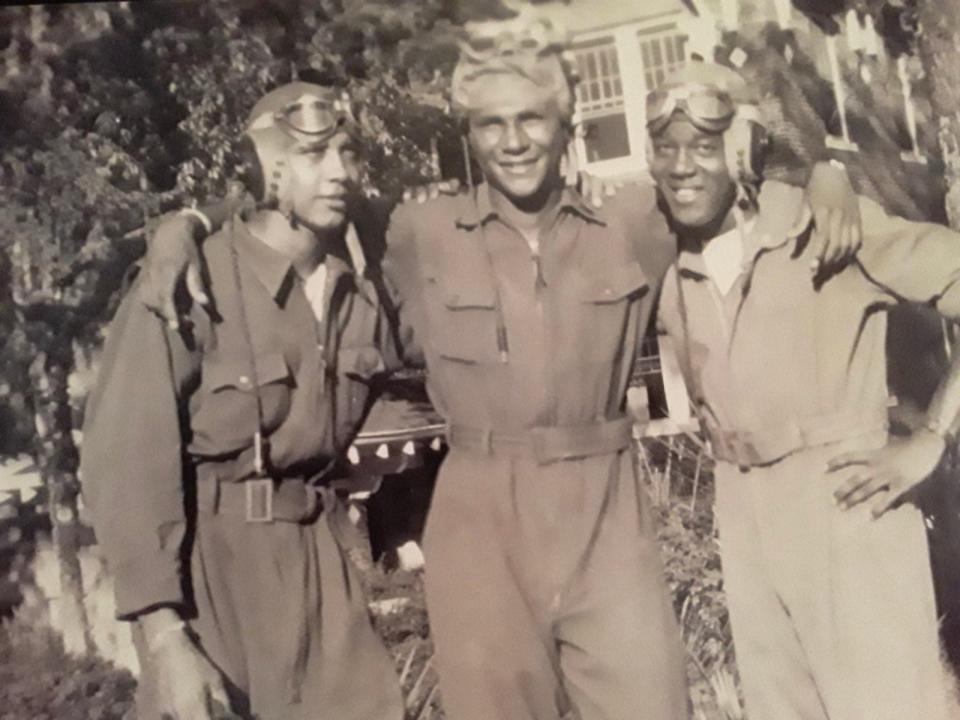'Ready, willing and able': A family remembers the long legacy one Tuskegee Airman left behind
As a teenager in the 1940s, Robert Higginbotham found himself in the midst of two major conflicts: a bloody world war, and the battle to extend equal rights to Black Americans at home in the United States.
At the time, many African American men and women were told they were unfit for combat and weren't capable of working complex machinery, Higginbotham's son said, like the bombers and other airplanes flown during the war in Europe.
"But dad, an academic, felt that he could master what would be necessary to operate an aircraft," Robert Higginbotham II, his son, said. "This was a very strong theme for all the airmen: victory overseas, and victory at home."
Higginbotham became part of the Tuskegee Airmen, the famed group of Black pilots who trained for and fought in World War II. Less than a century ago, they were the first African American military aviators in the United States Army Air Corps.
He later earned his medical degree, relocated to Southern California and eventually settled in Rancho Mirage with his wife, Margaret.
Dr. Robert Higginbotham died last week at 96 years old, only a few days shy of Memorial Day. Most of the roughly 1,000 pilots (and the thousands of other ground personnel) who trained at Tuskegee Army Air Field in Alabama have died, leaving just a few who can still recall those turning points of the 20th century — the end of a world war, desegregation — first-hand.

Despite the Tuskegee Airmen's prominent place in history books, Robert said his dad and his friends often viewed their service matter-of-factly, rather than as a vital piece of that official record.
"They didn't really look at it like that," he said. "They knew what they did was special, they knew it was important. But it wasn't like we look at it today, as the accomplishment that it was."
Enlisting in the military, even for those who were initially discouraged from doing so based on their race, was merely a fact of life, he said. "If you were able and young," he said, "you were gonna serve."
'The best of the best'
As World War II began, direct discrimination and segregation still kept many Black Americans out of the U.S. armed forces.
After lobbying efforts from civil rights groups, historic Black colleges and universities, and Black newspapers, President Franklin D. Roosevelt's administration announced the first Black military aviator group in 1940. Recruits for the new program came from around the country to train in Tuskegee, Alabama, the "heart of the Jim Crow South."
“They fought for their right to protect and defend the very people who saw them as inferior, less than and unworthy,” said Rep. Raul Ruiz, D-Palm Desert, at a Memorial Day ceremony last year, where four life-size bronze statues of Tuskegee Airmen were unveiled at the Palm Springs Air Museum. Higginbotham was honored at the 2021 ceremony alongside other Tuskegee Airmen Rusty Burns and Jerry Hodges.
The armed forces were finally desegregated several years after the war ended, in 1948, via executive order.
Meanwhile, Higginbotham, born on April 2, 1926, was fresh out of high school when he enlisted, leaving home for the first time and following his older brother Mitchell to Tuskegee. At 17 years old, he joined toward the tail end of the war and never got sent overseas.
But Robert said his father's trip down to the airfield for pilot training from Sewickley, Pennsylvania, where he had grown up, was a challenge in itself; when his train passed below the Mason-Dixon Line, Higginbotham was forced to move to another car.
"You have to understand that my father is in uniform, and you have a policeman or a conductor saying, 'Boy, you gotta move,'" Robert said. "This was a major insult to the guys that were serving their nation."
Though the Tuskegee Airmen contended with abject racism before, during and after their service, the group was undoubtedly made up of "brilliant" people, Robert said. "They were the best of the best," he said. "They came from the top echelons of education, experience and exposure for African Americans in this country."
In 2007, Higginbotham, his brother Mitchell and about 300 other Tuskegee Airmen were awarded the Congressional Gold Medal by President George W. Bush. Mitchell Higginbotham died in 2016 at 94 years old.
After serving with the airmen, Higginbotham had a second act as an orthopedic surgeon for many decades. He and a business partner ran their own surgical practice in Southern California, and he also worked in the emergency rooms of Los Angeles.
Higginbotham and his wife bought a home in the 1970s in Rancho Mirage, where they eventually moved full-time. The two were married for nearly 70 years.
All told, his dad's legacy is likely one of service, Robert said: He worked hard and "genuinely wanted to help people."
"Ready, willing and able," Robert said. "That's what dad was."
In addition to his wife Margaret and son Robert, Higginbotham is survived by his son Michael. Instead of flowers, his family asks for donations to the Tuskegee Airmen Scholarship Foundation.
Amanda Ulrich covers Native American tribes and desert communities in Southern California for The Desert Sun, part of the USA Today Network. Reach out on Twitter @AmandaCUlrich.
This article originally appeared on Palm Springs Desert Sun: On Memorial Day, one family remembers the legacy of a Tuskegee Airman

